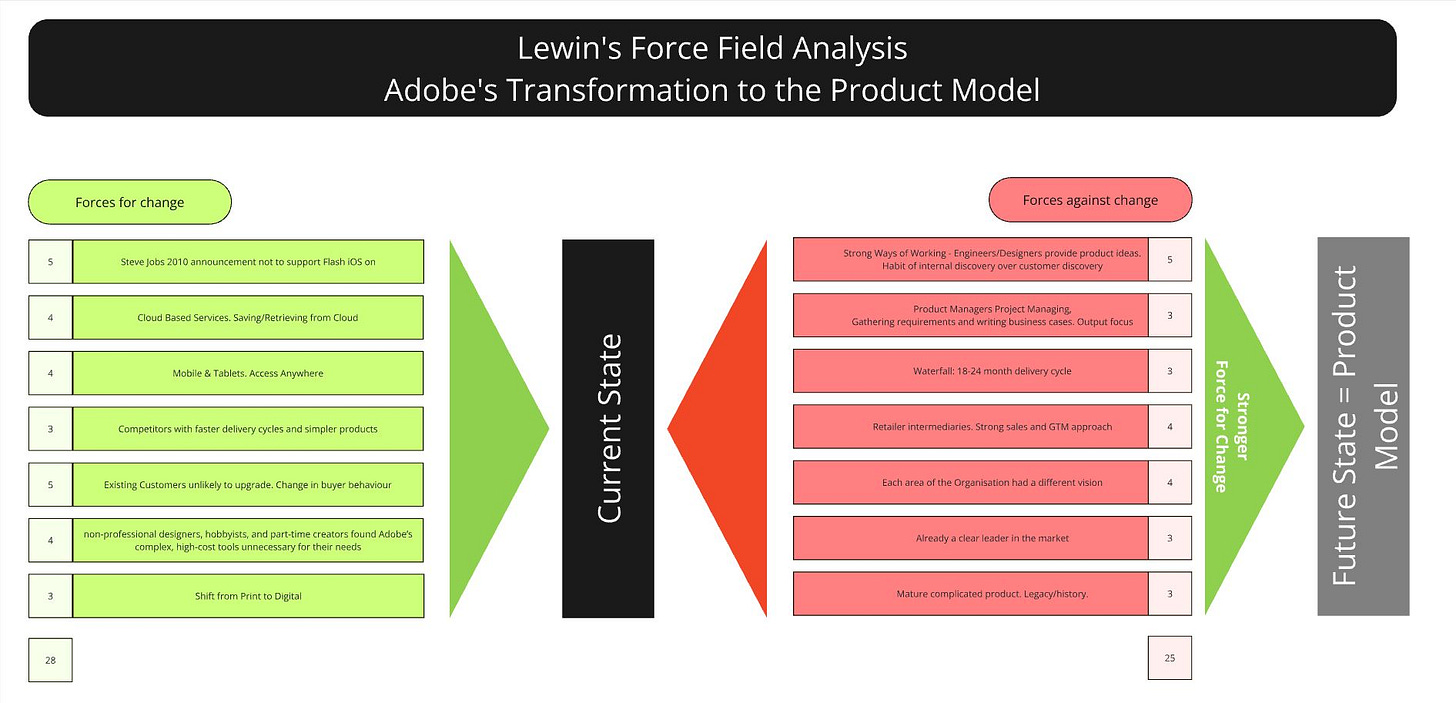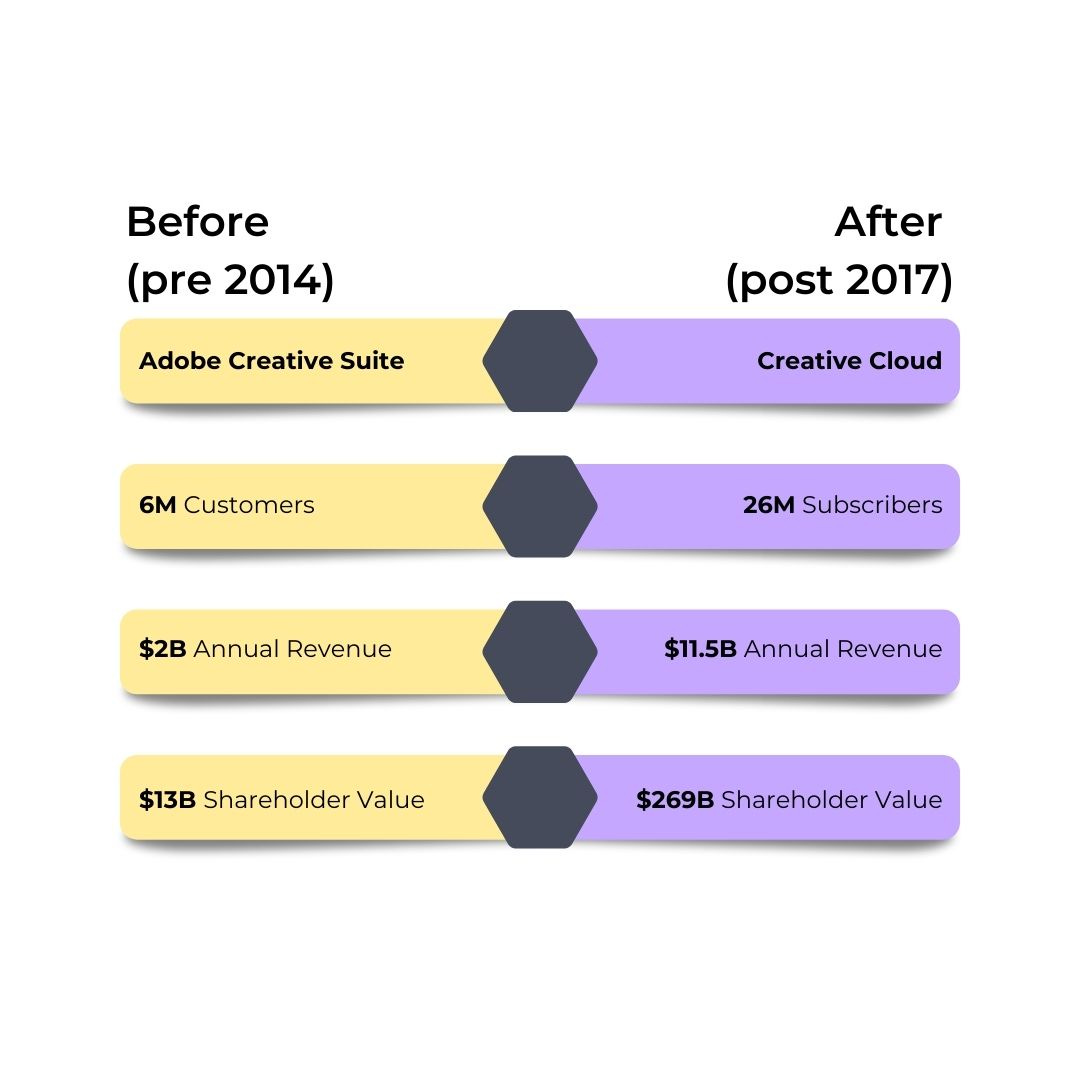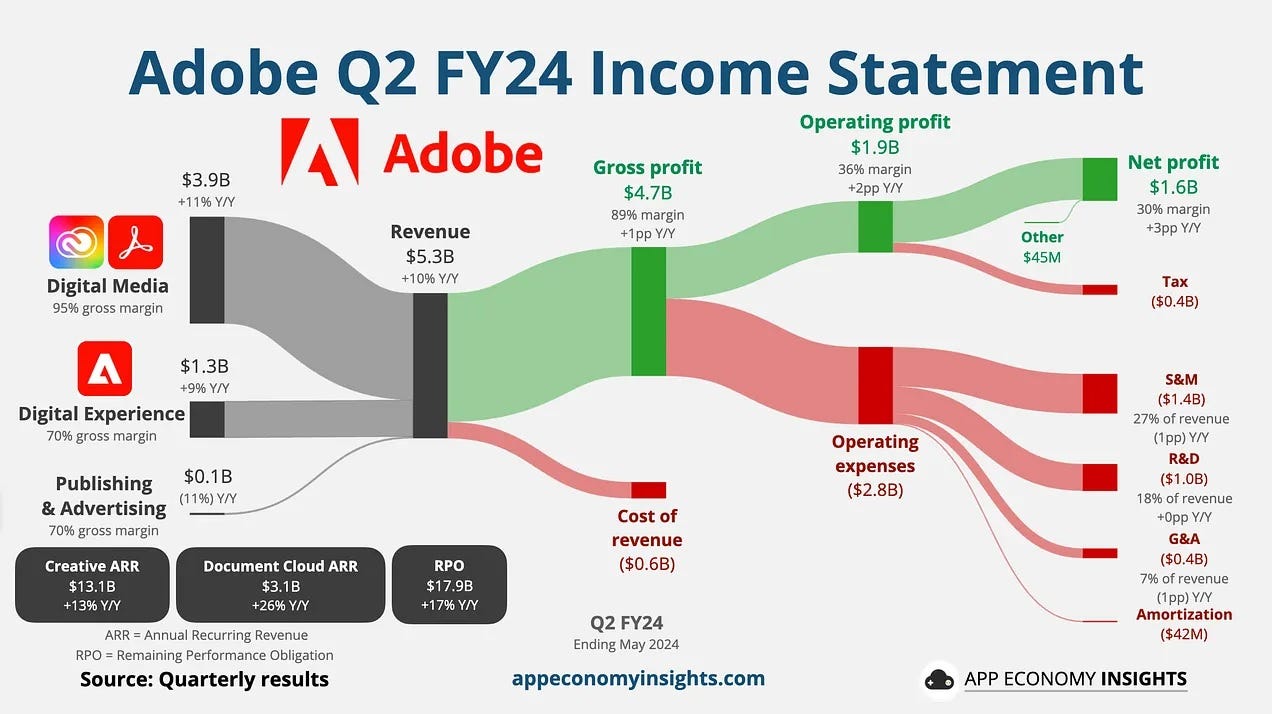Adobe: Transforming to the Product Model
From $13B Shareholder Value to $269B Shareholder Value. But what are the Adobe results now - years after the Transformation to the Product Model?
I’ve been fascinated with the intersection of change, product management and what motivates people for as long as I can remember.
So when Marty Cagan with Lea Hickman, Christian Idiodi, Chris Jones and Jon Moore released the book “Transformed: Moving to the Operating Model” I must have been one of the first to download and listen to it on Audible in March 2024.
Then watched the book launch with Dan Olsen (15 March).
Then read the physical copy of the book (which Marty signed for me) and attended the Transformed workshop in Sydney in June along with the Product Coaches dinner that evening.
In many ways, what was outlined in the book (the how) was not a surprise for me and many people have written about this.
But the results had me interested.
Finally, we can quantify the impact of the cultural and ways of working change that need to happen to adopt the Product Model.
Let’s talk Results
Summoning my inner Simon Sinek, let’s start with WHY?
Why change if what we’re doing is OK?
Why change if the results are moving in the right direction?
Why embark on a period of transformation, culture change, ways of working change, mindset shift?
Why get into the pain of years of transformation without knowing whether it’ll get us to the result we want?
Well, a few 5 Whys sessions later - I feel like the SVPG team have nailed it.
This is one of 7 articles on the organisations positively impacted by moving to the Product Model that is outlines in the book “Transformed: Moving to the Operating Model” and what happened after the book was published.
And, what do the results look like now?
Let’s start with Adobe.
Adobe – from $13B to $269B Shareholder Value
At page 257 in the book (Part IX written by Lea Hickman), I started really paying attention.
For someone that had held and managed the product P&L in most of my product roles, the financial outcome Adobe enjoyed from moving to the Product Model had me thinking of the many monthly product performance review conversations I had with the C-suite.
These numbers speak for themselves.
If you, like me, have ever had to seek CEO and C-suite support to improve the performance of your Product, you know that speaking the language of the C-suite, talking about the financials, is Key.
If you haven’t, master this skill and learn from me at the Product Commercials Masterclass - P&L for Product Managers starting this week!
Adobe. (part IX)
Category: Software. Creative Tools.
Location: San Jose, California
Head of Product for Adobe Creative Cloud (at the time): Lea Hickman
Problem
Adobe, founded in 1982, became a dominant force in creative software with tools like InDesign, Illustrator, and Flash, primarily sold through a one-time purchase model as part of the Creative Suite. I remember using the CD-Roms to install the programs and spending hundreds of dollars to purchase in early 2000s.
By the mid-2000s, however, Adobe faced significant challenges as the industry shifted. The rise of cloud-based services, mobile apps, and competitors like Sketch threatened Adobe’s traditional business. Additionally, long 18-24 month product cycles could not keep up with market changes.
The biggest driver for change came in 2010 with Steve Jobs’ rejection of Flash for iOS as Adobe’s Creative Professional customers loved Apple’s products.
The market was also evolving, with a growing number of non-professional designers, hobbyists, and part-time creators who found Adobe’s complex, high-cost tools unnecessary for their needs.
The business model focused on selling upgrades of the mature product to existing customers and full versions to new ones. The business case, before each release, projected sales based on confidence in the product achieving market fit. But, data suggested customers were satisfied with their current tools, making upgrades less likely.
The team questioned whether the new release offered enough value to drive upgrades or purchases.
Customer behaviour was changing to mobile first, using the mobile camera, storing and retrieving files from the cloud and enjoying faster download speeds. Purchasing software online over visiting a physical retail store became the new norm. This was an opportunity for a direct to consumer go to market approach, that came with many changes.
Culturally, Adobe was structured around a product development process driven by engineers and designers, with limited customer interaction or market-driven decision-making. Ideas came from internal sources - engineers and designers - without much validation. Releases were waterfall and slow.
The company needed to empower cross-functional product teams, including product managers, product designers, and engineers, to work directly with customers to understand their challenges and develop solutions.
Product managers were focused on project management, gathering requirements, the business case and ensuring on-time delivery for release cycles, but they lacked the authority to drive customer-focused product discovery.
The company’s sales were also heavily reliant on physical retail, selling boxed software, which was becoming obsolete as digital downloads gained prominence.
How to assess the change
I couldn’t resist taking all the factors that led up to the transformation (the motivation) and mapping them in Lewin’s Force Field Analysis to assess how difficult or easy it may be to implement this change to Adobe’s ways of working.

Lewin's Force Field Analysis helps us understand and manage the forces that drive change, those that resist change and how to assess any transformation activity.
The current state of the organisation is held in place (equilibrium) by two forces - one side supporting the need for change and the other side resisting the change.
On the right, list the forces that are supporting the change. These are the Arguments for Change or the Case for Change. The Driving Forces.
On the left, list the forces that are resisting change. These are the Arguments to keep things as they are. The Resisting Forces.
Forces may be external factors such as changes in the political, economic, social, technology, environmental and legal external environment (PESTEL) or internal factors specific to the organisation.
Force Field Analysis is used to understand the drivers for and against change at Adobe as discussed by Lea Hickman in Marty Cagan and SVPG's "Transformed: Moving to the Operating Model"
How to use the Force Field Analysis
Gather evidence supporting the change and resisting the change with a group across your organisation. Best done as a team.
List the Forces driving the change and the forces resisting the change
Once you've listed the forces, ask how strong is this force?
Where 1 is relatively weak and 5 is very strong.
Then add the forces for the change and the forces against the change.
Which force is the strongest?
If the forces for the change is higher = the change will be easier to implement
If the forces resisting the change is higher = ask yourself, is the change necessary? If so, what might need to happen to weaken the resisting forces and increase the strength of the driving forces?
Read more about Reducing Resistance and Increasing Support here
Stakeholder Analysis and Mapping
While “Transformed: Moving to the Operating Model” explained the change at a high level, to implement a transformation well, you would need to understand the stakeholders, internal and external, that could support or hinder the change.
Understanding their struggling moments through a Jobs To Be Done approach utilising Eckhart Boehme’s Wheel of Progress and creating a Stakeholder Radar and CIPD Mapping may help.
What is the Wheel of Progress?
The Wheel of Progress, created by Eckhart Boehme is used to understand the struggling moment that make consumers decide to buy a product, stay and pay.
The Struggling Moment is part of Jobs to Be Done and explained by Bob Moesta .
The canvas has been used to understand Customers, empathise with their context, struggles and understand why they choose what they do.
How is the Wheel of Progress used here?
Here the Wheel of Progress is used to understand stakeholders or internal people within an organisation and why they do what they do.
Specifically it is being used to understand the thinking within the employees at Adobe when faced with the transformation to the Product Model as discussed by Lea Hickman in Marty Cagan and SVPG's "Transformed: Moving to the Operating Model"
This canvas has been informed by the Transformation experience written about in "Transformed: Moving to the Operating Model" along with some creative licence on what people may have been feeling / thinking internally during a transformation.
Learn more about the Wheel of Progress and Eckhart Boehme here
Hear Bob Moesta explain the Struggling Moments and JTBD here
Learn more about the Adobe Transformation at "Transformed: Moving to the Operating Model"
Transformations that Sticks
When thinking about Transformation and Change, it's worth thinking about the Company Culture, History of Change, forces supporting the change and forces that resist the change (Lewin's Force Field Analysis). Kotter's 8 Accelerators for Change is an approach to help guide any transformation:
Establishing Urgency
Forming a Powerful Coalition - both with leaders supporting the change and an army of volunteers
Create a Vision for Change
Communicate and Sharing the Change Vision
Empowering Employees
Celebrating Visible Short Term Wins
Keeping the pressure and visibility on the change. and
Anchoring Change to Culture
From the Adobe Transformation Story in "Transformed: Moving to the Operating Model" we know:
Urgency was established through the 2010 Steve Jobs Announcement = meaning they had a limited time to derisk loss of business from Apple not supporting Flash
The Powerful Coalition started with the CTO Kevin Lynch, SVP of the Platform Business David Wadhwani and SVP of the Creative Business Johnny Loiacono announcing the offsite.
The Vision was created during the offsite after each product category was empowered to present and demo their product ideas and it was realised a unified Product Vision was needed along with a strong Product Leader to drive the vision (Lea Hickman)
If you’re interested in this (how) detour, I’ve place a lot of this thinking here on Miro.
Now back to the Transformation Story in “Transformed: Moving to the Operating Model”
Solution
To address these challenges, Adobe underwent a major transformation, moving from a one-time purchase model to a cloud-based subscription service, the Creative Cloud.
This allowed Adobe to continuously deliver updates to its software, addressing the need for more frequent innovation and reducing reliance on major, long development cycles. The subscription model offered lower upfront costs, making Adobe’s tools more accessible to smaller design firms, hobbyists, and freelancers, while also ensuring recurring revenue for the company.
It broadened their appeal beyond the serious designers.
The company also restructured internally, empowering cross-functional product teams that included product managers, designers, and engineers. Product managers took on a new, critical role—moving from being project managers to becoming product discovery leaders, focused on identifying and solving real customer problems.
The focus shifted from delivery to discovery - “Are we solving the right problem?”
These teams began engaging directly with customers to understand evolving needs, which was particularly important as designers shifted to using mobile devices and cloud-based tools for ideation and collaboration.
Adobe also shifted its go-to-market strategy, reducing reliance on retail channels and moving to direct digital distribution. This was facilitated by the growth in digital downloads and faster internet speeds.
Adobe no longer sold boxed software, instead encouraging users to subscribe directly through its website.
They got closer to the end user.
The product strategy was driven by a unifying vision aimed at solving core customer problems. Adobe’s leadership articulated this vision through a narrative centred around a hypothetical freelance designer, Marissa. This helped align the company’s efforts around building solutions that addressed the daily needs of designers—such as cloud syncing, mobile integration, and more affordable tools—across all their devices.
Key problems Adobe prioritised included identity management (ensuring users could easily access their tools across platforms) and seamless cloud syncing of data between devices.
These were the same problems we were concerned with in mid 2000s at Telstra.
Adobe also reworked its development practices, shifting from a waterfall model to continuous integration and delivery (CI/CD), which allowed faster release cycles and more responsive product updates.
Results
Adobe had to undergo changes in how they decided which problems to solve, how they solved problems and how they built.
How you decide which problems to solve:
A compelling product vision was created with a focus on the end customer, the pain they were experiencing and problems to solve. It was brought to life with the aspirational “day in the life” story about Marissa a freelance graphic designer who needed to pitch the creative director at Nike with her proposal. The visiontype and narrative guided the teams. They shared it with key designer customers, stakeholders. It informed changes to the Go to Market approach and implications for marketing, sales, and finance. Gaps to fill to achieve the vision were identified and priortised to solve. Two customer problems based on insights were identified that needed to be solved - identity management and cloud based data syncing.
How you solve problems
From internal engineers and designers presenting the product managers with ideas to implement to a customer centric discovery approach the product managers led.
From building on legacy desktop technology, they bravely moved to cloud based and native mobile experiences. Continuous Innovation and Continuous Discovery with empowered teams that included engineering, design, product managers and product marketers. The Product management role changed substantially from project management and requirements gathering to leading discovery with a focus on solving customer problems.
How you build
They shifted from a 12-18 month waterfall releases for continous development and delivery. There was resistance from engineering but not enough detail about how they overcame the personal resistance. There was significant architectural changes that needed to happen to support the new strategy.
What Happened Next?
While $11.5B was the Revenue in the book as of 2017, based on the Adobe Q2 FY24 Income Statement, it’s currently looking like surpassing $20B this financial year.
This is where the results in a product approach is - longer term sustainable growth.
Setting up the product operations in a way that supports year on year growth. Creating not only Value for the Customer but Viability for the Business.
Product Commercials Masterclass
Need to understand more about these longer term business viability goals?
Join the Product Commercials Masterclass.
I take you through how to read an Income Statement or P&L in the Product Commercials Masterclass - P&L for Product Managers
The lessons are bite sized over a few days so you get a chance to practice and use what you’ve learnt in your day to day work!
Want Future Product Transformation Change Stories?
While Adobe’s results are impressive, there are more great examples in Transformed. The other great examples that Marty takes us through are Almosafer, CarMax, Datasite, Kaiser Permanente and Trainline.
Want to go deep into the other Transformation Stories and
View the change from a Force Field Analysis Change lens and let’s get into the HOW of delivering transforming to the Product Model
Find out whether the results continued after the book was published?
Subscribe and be notified when the next Transformation Story drops.
Are you new to Product Management and want to learn from me?
I created a Course. For people new to Product Management.
Aligned it with the Learning Outcomes created by Product greats like Jeff Patton and others. Had it certified by the globally recognised ICAgile.
Choose to spend 2 days learning from me - either face to face or via Zoom - with ICAgile Certified Professional in Product Management (ICP-PDM).
And if you’re looking for a sneaky discount, send me an email at irene@phronesisadvisory.com







